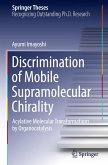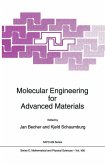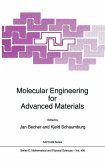Advances in Organic Crystal Chemistry
Comprehensive Reviews 2020
Herausgegeben:Sakamoto, Masami; Uekusa, Hidehiro
Advances in Organic Crystal Chemistry
Comprehensive Reviews 2020
Herausgegeben:Sakamoto, Masami; Uekusa, Hidehiro
- Broschiertes Buch
- Merkliste
- Auf die Merkliste
- Bewerten Bewerten
- Teilen
- Produkt teilen
- Produkterinnerung
- Produkterinnerung
This book summarizes and records the recent notable advances in diverse topics in organic crystal chemistry, which has made substantial progress along with the rapid development of a variety of analysis and measurement techniques for solid organic materials. This review book is one of the volumes that are published periodically on this theme. The previous volume, published in 2015, systematically summarized the remarkable progress in assorted topics of organic crystal chemistry using organic solids and organic-inorganic hybrid materials during the previous 5 years, and it has been widely read.…mehr
Andere Kunden interessierten sich auch für
![Advances in Organic Crystal Chemistry Advances in Organic Crystal Chemistry]() Advances in Organic Crystal Chemistry112,99 €
Advances in Organic Crystal Chemistry112,99 €![Advances in Organic Crystal Chemistry Advances in Organic Crystal Chemistry]() Advances in Organic Crystal Chemistry224,99 €
Advances in Organic Crystal Chemistry224,99 €![Discrimination of Mobile Supramolecular Chirality Discrimination of Mobile Supramolecular Chirality]() Ayumi ImayoshiDiscrimination of Mobile Supramolecular Chirality127,99 €
Ayumi ImayoshiDiscrimination of Mobile Supramolecular Chirality127,99 €![Molecular Engineering for Advanced Materials Molecular Engineering for Advanced Materials]() BecherMolecular Engineering for Advanced Materials161,99 €
BecherMolecular Engineering for Advanced Materials161,99 €![Molecular Engineering for Advanced Materials Molecular Engineering for Advanced Materials]() Molecular Engineering for Advanced Materials161,99 €
Molecular Engineering for Advanced Materials161,99 €![Crystal Engineering: From Molecules and Crystals to Materials Crystal Engineering: From Molecules and Crystals to Materials]() BragaCrystal Engineering: From Molecules and Crystals to Materials81,99 €
BragaCrystal Engineering: From Molecules and Crystals to Materials81,99 €![Calixarenes 50th Anniversary: Commemorative Issue Calixarenes 50th Anniversary: Commemorative Issue]() Calixarenes 50th Anniversary: Commemorative Issue149,99 €
Calixarenes 50th Anniversary: Commemorative Issue149,99 €-
-
-
This book summarizes and records the recent notable advances in diverse topics in organic crystal chemistry, which has made substantial progress along with the rapid development of a variety of analysis and measurement techniques for solid organic materials. This review book is one of the volumes that are published periodically on this theme. The previous volume, published in 2015, systematically summarized the remarkable progress in assorted topics of organic crystal chemistry using organic solids and organic-inorganic hybrid materials during the previous 5 years, and it has been widely read. The present volume also shows the progress of organic solid chemistry in the last 5 years, with contributions mainly by invited members of the Division of Organic Crystal Chemistry of the Chemical Society of Japan (CSJ), together with prominent invited authors from countries other than Japan.
Produktdetails
- Produktdetails
- Verlag: Springer / Springer Nature Singapore / Springer, Berlin
- Artikelnr. des Verlages: 978-981-15-5087-4
- 1st edition 2020
- Seitenzahl: 548
- Erscheinungstermin: 11. Juli 2021
- Englisch
- Abmessung: 235mm x 155mm x 30mm
- Gewicht: 820g
- ISBN-13: 9789811550874
- ISBN-10: 9811550875
- Artikelnr.: 62078888
- Herstellerkennzeichnung Die Herstellerinformationen sind derzeit nicht verfügbar.
- Verlag: Springer / Springer Nature Singapore / Springer, Berlin
- Artikelnr. des Verlages: 978-981-15-5087-4
- 1st edition 2020
- Seitenzahl: 548
- Erscheinungstermin: 11. Juli 2021
- Englisch
- Abmessung: 235mm x 155mm x 30mm
- Gewicht: 820g
- ISBN-13: 9789811550874
- ISBN-10: 9811550875
- Artikelnr.: 62078888
- Herstellerkennzeichnung Die Herstellerinformationen sind derzeit nicht verfügbar.
Masami SAKAMOTO Masami Sakamoto, Professor of Graduate School of Engineering at Chiba University, was born in 1957 in Ibaraki. He received B. of Science (1979), M. of Science (1982), and D. of Science (1987) degrees from The University of Tsukuba. In 1985, he joined Faculty of Engineering at Chiba University as a Research Associate (1985-1994), appointed to Associate Professor in 1994, and promoted to Professor of Graduate School of Engineering at Chiba University in 2003. His major field is organic synthesis and solid-state chemistry. His current interests include 1) Dynamic preferential crystallization and 2) Asymmetric synthesis using crystal chirality. He received the Molecular Chirality Award from the Molecular Chirality Research Organization in 2014. Hidehiro UEKUSA Hidehiro Uekusa, Associate Professor of Department of Chemistry at Tokyo Institute of Technology, was born in 1964 in Tokyo. He received B. of Science (1987), M. of Science (1989), andD. of Science (1992) degrees from Keio University. In 1992, he joined the Department of Chemistry at Tokyo Institute of Technology as a Research Associate (1992-1999), and appointed to Associate Professor in 1999. His major field is chemical crystallography. His current interests include 1) Crystal structure and properties design of pharmaceutical crystals, 2) Analysis of crystalline state reactions, and 3) Crystal structure analysis from powder diffraction data. He received the Research Award from the Crystallographic Society of Japan in 2012.
Part I Nucleation and Crystal Growth.- X-ray Birefringence Imaging: A New Technique to Characterize Bond Orientational Distributions in Organic Materials.- Direct Visualization of Crystal Formation and Growth Process Probed by the Organic Fluorescent Molecules.- Anti-solvent Crystallization Method for Production of Desired Crystalline Particles.- Crystal Nucleation of Proteins Induced by Surface Plasmon Resonance.- Control of Crystal Size Distribution and Polymorphs in the Crystallization of Organic Compounds.- Managing Thermal History to Stabilize/Destabilize Pharmaceutical Glasses.- Part II Structure and Design of Crystals.- Supramolecular, Hierarchical and Energetical Interpretation of Organic Crystals: Generation of Supramolecular Chirality in Assemblies of Achiral Molecules.- Relationship Between Atomic Contact and Intermolecular Interactions: Significant Importance of Dispersion Interactions Between Molecules without Short Atom-atom Contact in Crystals.- PharmaceuticalMulticomponent Crystals: Structure, Design, and Properties.- The Design of Porous Organic Salts with Hierarchical Process.- Layered Hydrogen-bonded Organic Frameworks as Highly Crystalline Porous Materials.- Kinetic Assembly of Porous Coordination Networks Leads to Trapping Unstable Elemental Allotropes.- Creation of Organic-Metal Hybridized Nanocrystals toward Nonlinear Optics Applications.- Part III Function.- Luminescent Crystal - Control of Excited-State Intramolecular Proton Transfer (ESIPT) Luminescence through Polymorphism.- Solid-State Fluorescence Switching Using Photochromic Diarylethenes.- Circularly Polarized Luminescence from Solid-State Chiral Luminophores.- Azulene-Based Materials for Organic Field-Effect Transistors.- Electronic Functions of Nanostructured Liquid Crystals with Electronic and Ionic Conductivity.- Part IV Chirality.- Kryptoracemates.- Twenty-Five Years' History, Mechanism and Generality of Preferential Enrichment as a Complexity Phenomenon.-Asymmetric Synthesis Involving Dynamic Enantioselective Crystallization.- Molecular Recognition by Inclusion Crystals of Chiral Host Molecules Having Trityl and Related Bulky Groups.- Asymmetric Catalysis and Chromatographic Enantiomer Separation by Homochiral Metal-Organic Framework: Recent Advances.- Part V Solid-State Reaction.- Solid-State Polymerization of Conjugated Acetylene Compounds to Form pi-Conjugated Polymers.- Click Chemistry to Metal Organic Frameworks as a Synthetic Tool for MOF and Applications for Functional Materials.
Part I Nucleation and Crystal Growth.- X-ray Birefringence Imaging: A New Technique to Characterize Bond Orientational Distributions in Organic Materials.- Direct Visualization of Crystal Formation and Growth Process Probed by the Organic Fluorescent Molecules.- Anti-solvent Crystallization Method for Production of Desired Crystalline Particles.- Crystal Nucleation of Proteins Induced by Surface Plasmon Resonance.- Control of Crystal Size Distribution and Polymorphs in the Crystallization of Organic Compounds.- Managing Thermal History to Stabilize/Destabilize Pharmaceutical Glasses.- Part II Structure and Design of Crystals.- Supramolecular, Hierarchical and Energetical Interpretation of Organic Crystals: Generation of Supramolecular Chirality in Assemblies of Achiral Molecules.- Relationship Between Atomic Contact and Intermolecular Interactions: Significant Importance of Dispersion Interactions Between Molecules without Short Atom-atom Contact in Crystals.- PharmaceuticalMulticomponent Crystals: Structure, Design, and Properties.- The Design of Porous Organic Salts with Hierarchical Process.- Layered Hydrogen-bonded Organic Frameworks as Highly Crystalline Porous Materials.- Kinetic Assembly of Porous Coordination Networks Leads to Trapping Unstable Elemental Allotropes.- Creation of Organic-Metal Hybridized Nanocrystals toward Nonlinear Optics Applications.- Part III Function.- Luminescent Crystal - Control of Excited-State Intramolecular Proton Transfer (ESIPT) Luminescence through Polymorphism.- Solid-State Fluorescence Switching Using Photochromic Diarylethenes.- Circularly Polarized Luminescence from Solid-State Chiral Luminophores.- Azulene-Based Materials for Organic Field-Effect Transistors.- Electronic Functions of Nanostructured Liquid Crystals with Electronic and Ionic Conductivity.- Part IV Chirality.- Kryptoracemates.- Twenty-Five Years' History, Mechanism and Generality of Preferential Enrichment as a Complexity Phenomenon.-Asymmetric Synthesis Involving Dynamic Enantioselective Crystallization.- Molecular Recognition by Inclusion Crystals of Chiral Host Molecules Having Trityl and Related Bulky Groups.- Asymmetric Catalysis and Chromatographic Enantiomer Separation by Homochiral Metal-Organic Framework: Recent Advances.- Part V Solid-State Reaction.- Solid-State Polymerization of Conjugated Acetylene Compounds to Form pi-Conjugated Polymers.- Click Chemistry to Metal Organic Frameworks as a Synthetic Tool for MOF and Applications for Functional Materials.








